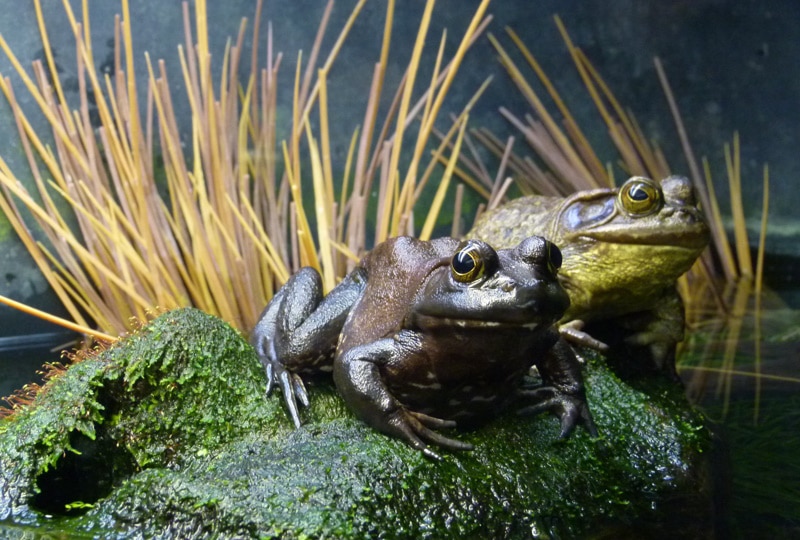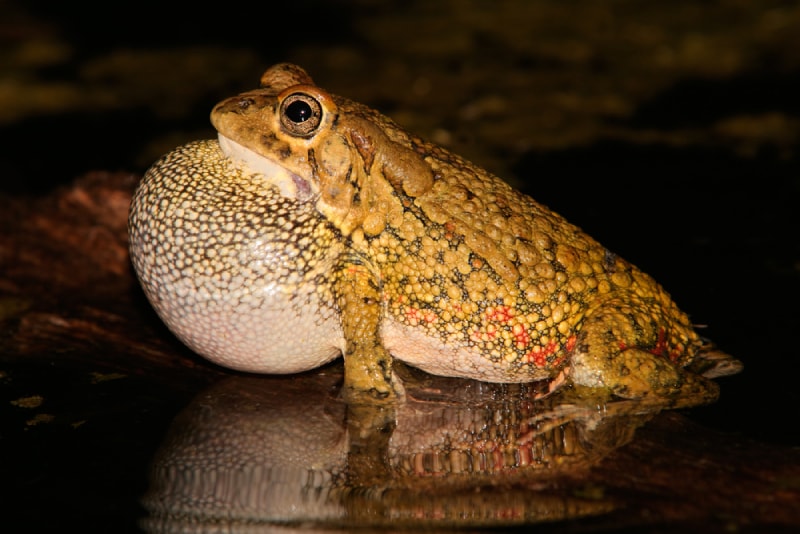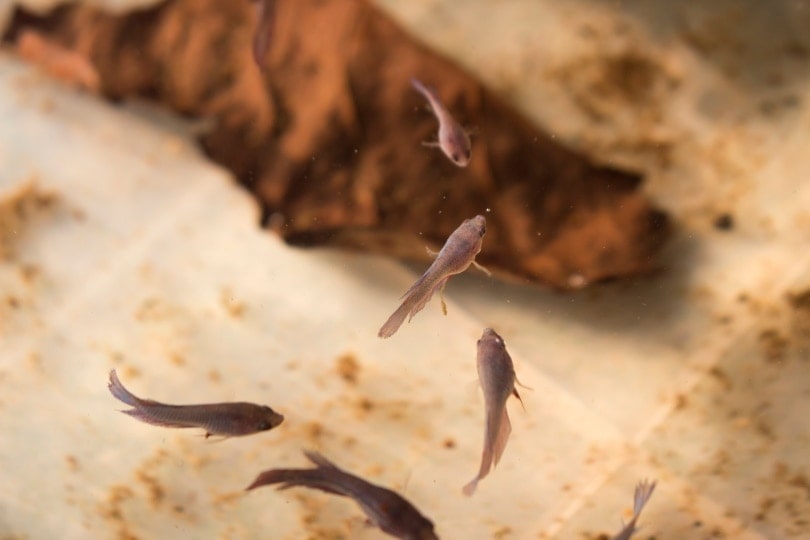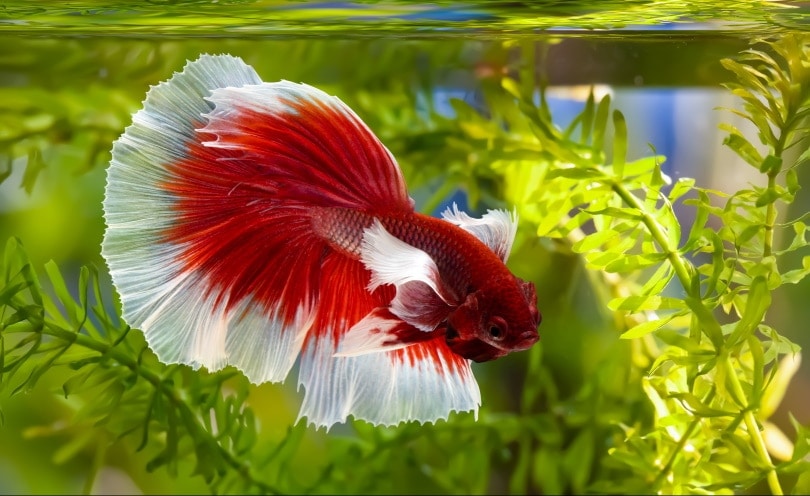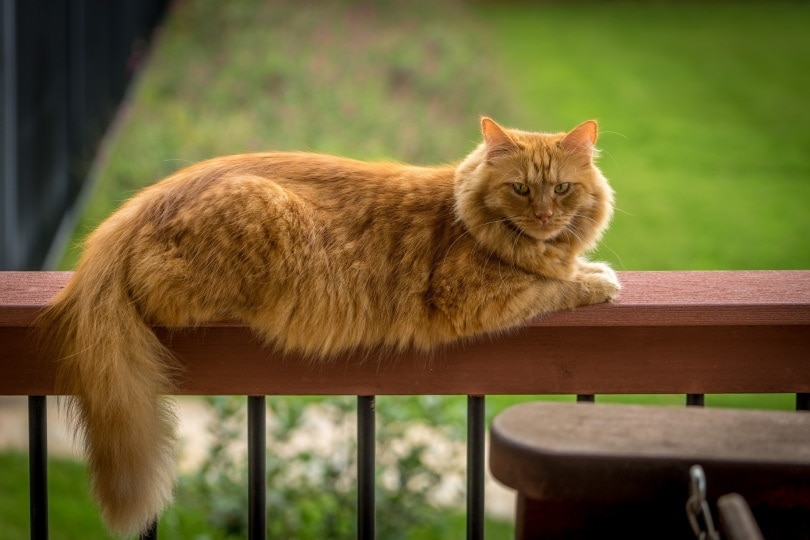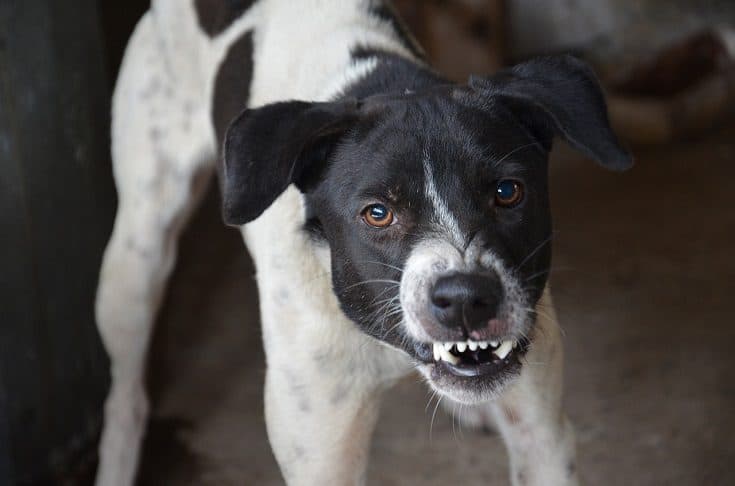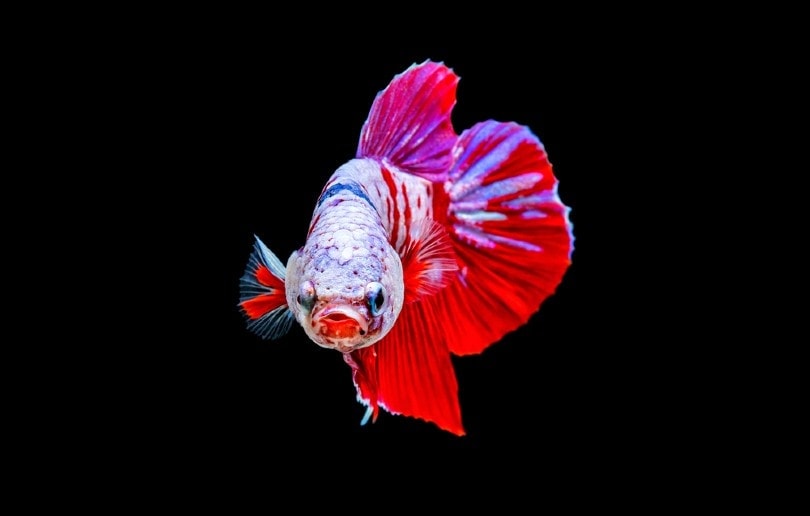African Bullfrog: Care Guide, Diet, Pictures & Lifespan
By Ashley Bates
Updated on
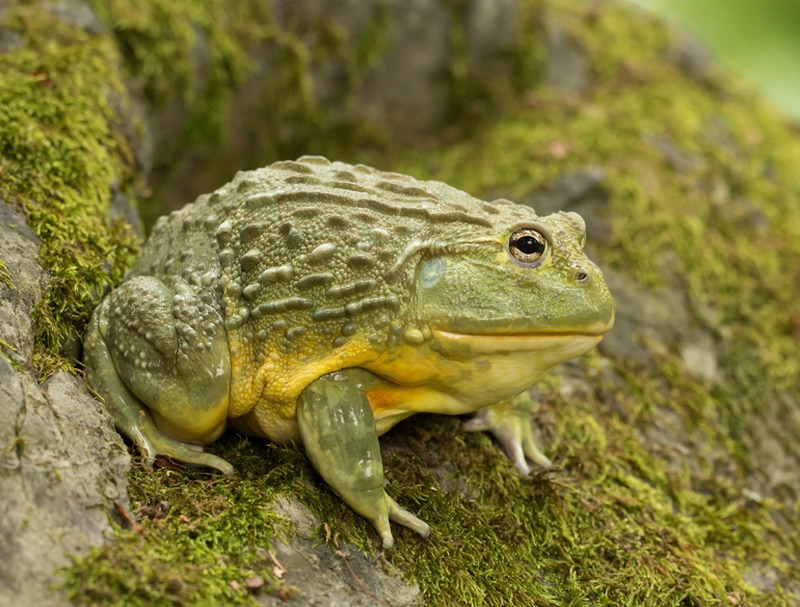
The African Bullfrog is a gigantic frog commonly kept in domestic environments. Many keepers love these guys because they are interesting to watch and easy to care for. If you’ve been thinking about bringing one into your home, you’ll undoubtedly want to know every in and out of care.
In this article, we’re going to explore how much African Bullfrogs cost, what setup you need, and how to optimize their living experience. Then, you can decide if you want the responsibility of this particular amphibian.
| Size: | 4.5 inches long |
| Lifespan: | 20 years |
| Color: | Olive green |
| Suitable for: | First-time, but amphibian-educated owners |
| Temperament: | Easy-going, low-maintenance |
| Diet: | Carnivorous |
| Tank Set-Up: | Bark substrate and fresh soaking water |
| Minimum Tank Size: | 30 gallons |
| Suitable Tank Mates: | Not advised |
African Bullfrogs are a popular choice of domestic frog because they are easy to care for and fun to keep. These frogs have voracious appetites and require an immaculate living environment to thrive.
So even though they are considered low maintenance and great first-time picks for inexperienced pet owners, you need to ensure that you are well-educated about these amphibians and that you have the proper setup as well as clean it appropriately so that your frog can live their best life.
African Bullfrog Characteristics
African Bullfrog Frog Overview
The African Bullfrog (Pyxicephalus adspersus) goes by many names, including the Pixie Frog, Giant Bullfrog, and South African Burrowing Frog. They inhabit dry savannas, subtropical shrublands, and near freshwater in the wild.
The African Bullfrog is a very sought-after pet frog species. Interestingly, their cousin, the American Bullfrog, is completely illegal to own in the United States. African Bullfrogs are extremely large and certainly make a pet your friends won’t forget.
Despite its size and sensitivities, this species is considered easy to care for. So, as long as first-time owners have the proper knowledge about this amphibian, you can easily manage their care at home, provided that you create an ideal habitat for them.
We will stress that these animals are not meant to be held much, as it can severely stress them out. These beauties are meant for observation only for the most part. So, you must understand before purchase that the interaction might not be as frequent as you’d prefer.

American Bullfrog Frog Cost?
The cost of an African Bullfrog can vary depending on where you purchased them. However, on average, they run between $25 and $75. You can find a breeder specializing in African Bullfrogs if you want to own one as a pet, as most breeders should be well-educated about the species and can ensure that it is healthy.
Occasionally you can find one at a pet shop, although the health of the African Bullfrog might not be as good. While pet shops aim to provide the best care for the animals, sometimes, a lack of specific education about certain animals can lead to a lack of proper care instead.
So, if you do purchase from a pet shop of some kind, make sure to thoroughly check over the frog for signs of illness or disease.
In addition to purchasing the bullfrog itself, you have to consider other things. Owning cold-blooded animals is not a cheap task upfront. You have to ensure they have proper lighting, a sizable tank, a supply of food, and proper substrate.
Since African Bullfrogs are such voracious eaters, they require a bountiful feast every meal. You can keep live gut-loaded insects on hand, but these require their own care. Often, folks choose to breed these insects themselves to save money.
Ultimately, with all supplies considered, you’re looking for upward of $350 for the frog and initial supplies in order to start caring for one of these animals.
Care Guide & Tank Set Up
Offering the appropriate tank setup will be the very first step to successful care. An African Bullfrog’s environment sets the foundation for everything else. Improper living conditions can lead to a drastically shortened lifespan, potential for disease, and other downfalls.
Tank Size
There’s some confusion when it comes to housing for African Bullfrogs. As you well know, they can get very large – up to 4 pounds per frog. However, they are usually pretty relaxed.
Since they don’t spend much time being super active in their enclosure, it can lead some people to believe that they don’t require much space. While they might not need as much as some other active species, they still require the appropriate amount of space.
These frogs grow very quickly. When you get them from a pet store, you might purchase a cage according to their current size, but keep in mind that they will get big rapidly.
At a minimum, your frog should have at least 30 gallons of space. Ideally, 55 gallons or more is a more appropriate amount of space for an adult African Bullfrog.
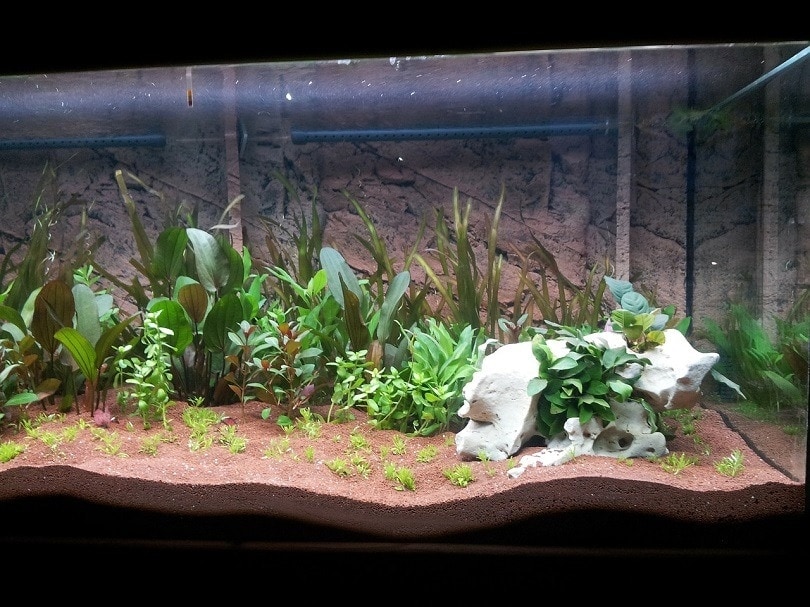
Substrate
African Bullfrogs are very notorious for swallowing their substrate. These frogs are burrowers, which means they love to dig and snooze under the surface.
For this reason, it is essential to purchase the correct kind of substrate. While there might be some mixed opinions on the subject, coconut husks are one of the best substrates you can get for an African Bullfrog. This type of substrate is better because it is easily digestible if it is swallowed by mistake.
Cage liners are also useful to promote easy cleaning.
Humidity
Humidity is one of the most important aspects of your African Bullfrog’s setup. These frogs require constant moisture to stay healthy. Their enclosure should maintain humidity levels between 80 and 90% at all times.
To ensure that these levels stay at a reasonable level, always by a hygrometer so that you can keep track visually.
Lighting
African Bullfrogs explicitly require 12 hours of daylight and 12 hours of night to maintain their appropriate schedules. Lighting is not only essential to mimic day and night cycles, but it also helps your frog regulate their body temperature, as these are cold-blooded creatures that require warmth from heat sources.
African Bullfrogs require UVA and UVB lighting to absorb vitamin D and maintain appropriate temperatures. These lights are also useful for maintaining proper daytime/nighttime cycles.

Heating
African Bullfrogs, like other amphibians, are cold-blooded creatures. That means you are responsible for providing all of their necessary heat inside of the enclosure. African Bullfrogs need a cool and warm side of the enclosure so they can regulate their body temperature.
A thermometer to monitor the temperatures will ensure your frog gets the correct amount of heat inside the space they dwell.
Things to Know When Owning an American Bullfrog
Food & Diet Requirements
African Bullfrogs are carnivores, and they are very efficient predators. These voracious frogs will eat just about anything! Their diet is not limited to insects like many other frog species. These frogs require a bountiful diet.
While they are young, they need a broad spectrum of gut-loaded insects to stay healthy. As they age, you will likely have to incorporate small rodents into their diet to meet their daily demands.
Since African Bullfrogs require an uptake of calcium, pink mice and whole fish are two excellent ways to introduce calcium into the diet. Crickets and other gut-filled insects are not enough to keep up with the needed supply of calcium for this particular amphibian.
You should also introduce the following foods into their diet:
- Crayfish
- Earthworm
- Grasshopper
- Snails
- Silkworms
- Roaches
- Minnows
- Shiners
You should powder the foods you offer with appropriate supplements to ensure a proper vitamin-to-mineral ratio. Since African Bullfrogs are voracious eaters, they often can eat substrate by mistake. It is best to feed them with tongs when possible.
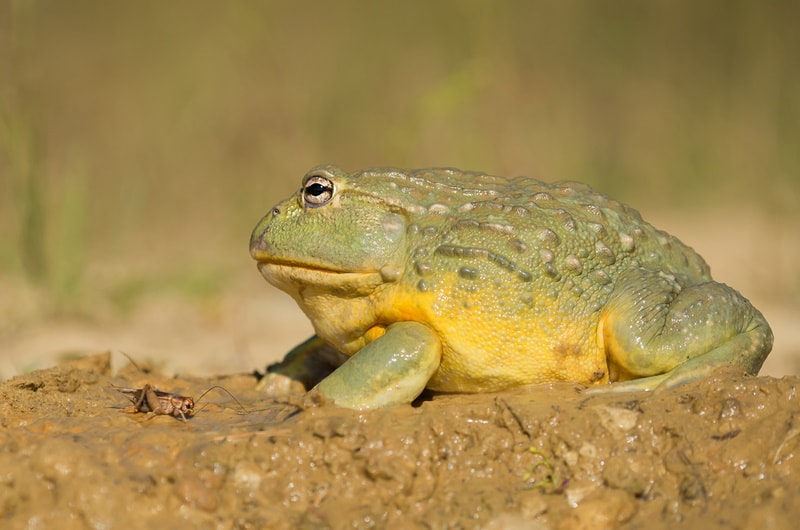
Water/ Liquid Requirements
Water should be changed out daily and always treated with some type of chlorine or chloramine remover. This will ensure that none of these contaminants get into your frog’s water and cause them to get ill.
African Bullfrogs love to soak; in fact, they will spend a large portion of their time doing this inside the enclosure. That is why it is imperative to have a water bowl big enough for them to submerge themselves in completely.
Some keepers choose to have one part of the enclosure mimic a pond-like structure. Just be careful not to add any other smaller critters into the mix, as they will surely become a food source for the bullfrog.
Size & Growth Rate
The African Bullfrog typically matures between 1 1/2 to 2 years of age. They grow exceptionally fast, averaging 1.4 inches in just 30 days! When they are fully grown, they weigh approximately 4.4 pounds.
However, there are some differences between male and female African Bullfrogs. The females stay relatively smaller and generally stay around 2 pounds. They also top out at 4.5 inches while their male counterparts continue to grow.
Handling
It would be best if you did not handle an African Bullfrog very often. The first reason is that they have very powerful jaws that bear sharp spikes known as odontoid structures. If they clamp down on a finger, it can cause some serious injury and pain.
Even though these bullfrogs are mostly very docile, they can sometimes bite by mistake or if frightened. So always move very slowly and handle them gently. Also, these frogs are covered with a protective layer of mucous. Handling the frog with your bare hands can cause the removal of the protective mucous, which is bad for their skin.
Also, handling can cause stress for any amphibian. So, it’s best to keep contact to a minimum with this species.

Lifespan and Health Conditions
While African Bullfrogs are generally very healthy, they can have certain health conditions crop up. An unsanitary, dirty environment causes the primary one. If your frog’s tank isn’t clean enough, it can leave them susceptible to many bacterial and viral infections.
In the event that something were to happen, it’s always best to have an exotic vet on hand. Exotic vets can sometimes be hard to locate, so it’s best to secure one before even bringing home an amphibian.
- Intestinal parasites
- Bacterial infections
- Fungal infections
- Chytridiomycosis
- Obesity
Male vs Female
There are several ways to tell the difference between male and female African Bullfrogs. First, the males are substantially larger, measuring roughly 9.5 inches as adults. Females, on the other hand, measure 4.5 inches at maximum growth.
Apart from size, there are some other ways to tell. Male African Bullfrogs have chubby bodies with an olive-green hue and a yellow or orange throat. Females also are the same olive-green color but have cream-colored throats.
In addition to visual appearance, males will loudly croak, but females do not vocalize at all. This telltale sign lets you know exactly what sex your African Bullfrog is.
3 Little-Known Facts About African Bullfrogs
1. African Bullfrog females can lay up to 4,000 eggs per clutch.
African Bullfrogs can have quite a few offspring! If you plan on breeding, you might want to know just what you’re getting into. In a single clutch, a female African Bullfrog can lay up to 4,000 eggs! Once they hatch, they develop very quickly, only 2 days after they emerge.
2. African Bullfrogs can live up to 40 years under human care.
It is quite common for an African Bullfrog to live up to 20 years in the wild. Under human care, they can live significantly longer, sometimes getting up to the 40-year mark.
3. African Bullfrogs will often cannibalize.
We’ve mentioned several times throughout the article that African Bullfrogs are highly voracious eaters. They will eat anything their size or smaller. So it might come as no surprise that they will also cannibalize their own species. They certainly aren’t picky!

Final Thoughts
Now you understand what it takes to keep an African Bullfrog successfully. This unique species should be a top contender for experienced and inexperienced owners alike. The primary thing to ensure is that you are well-educated about the species and maintain a proper environment.
These frogs require very specific living conditions to ensure their health and prevent any avoidable issues. Remember, there are better frogs than these if you want to have tank mates, as they can be aggressive with their own species and eat anything that’s their size or smaller.
Featured Image Credit: Milan Zygmunt, Shutterstock

